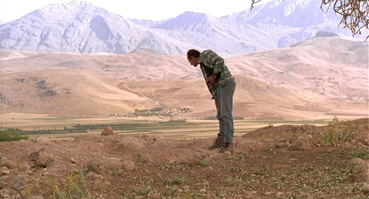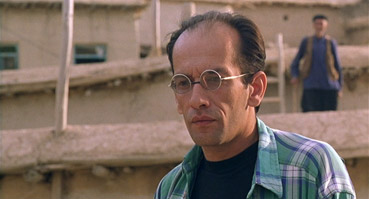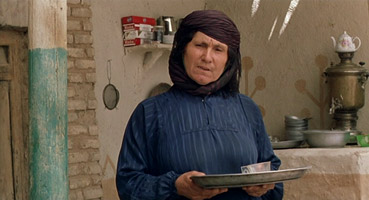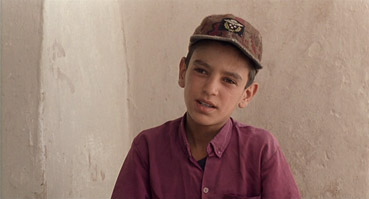| Behzad: "Why don't we go to your mother's?" |
| Farzad: "She says that our house is too small and that you deserve better." |
| Behzad: "I think your mother's wrong. Small things have their value too." |
For many western viewers, their first experience of Iranian cinema will require a little adjustment. It's not just the differences in language, culture, character and setting, but an approach to cinematic storytelling not much practiced in Europe and America. If you're lucky then you'll already find that you're subconsciously tuned to this style of filmmaking and will embrace it immediately. This certainly happened to me, and my first Iranian film experience – Mohsen Makhmalbaf's 1996 Gabbeh, a small-scale film about an elderly couple and a storytelling rug – genuinely left me reeling. But if you prefer your movies fast paced and crammed with incident then you're likely to struggle. Iranian films are almost exclusively character based, their stories often simple and told without urgency, and they frequently feature non-actors in key roles. And yet in their themes, their characters and their attention to detail, they represent some of the richest work in modern world cinema. Their sometimes telling use of subtext is the result, it has been reasoned, of the filmmakers having to work under a system in which government approval is required to even get a film into production, giving rise to the sort of smuggling of ideas that made some of the best work to emerge from Hays Code America so thematically interesting.

What's become known as the Iranian New Wave came to international prominence in the late 80s and early 90s, primarily through the work of filmmakers Mohsen Makhmalbaf – whose entire family appear to have become directors under his guidance – and Abbas Kiarostami. Now I don't propose to recount the life stories of these two fine gentlemen, as half of you will already know them and their work and the rest can easily cut and paste the names into your search engine of choice and chase down the information elsewhere. The only time I am aware that the two worked together on a single project was Kiarostami's 1990 film Close-Up [Nema-ye Nazdik], which told the true story of Ali Sabzian, a man who was arrested for conning his way into people's homes by pretending he was Mohsen Makhmalbaf. The film blended documentary footage of Sabzian's trial with recreations of his adventures in impersonation, which were made all the more intriguing by Kiarostami's decision to have Sabzian and the members one family whose home he invaded play themselves in the reconstructions, a technique later also employed by Makhmalbaf's daughter Samira in her 1998 film The Apple [Sib], and Makhmalbaf himself in his wonderful 1996 A Moment of Innocence [Nun va Goldoon]. In recent years Kiarostami has moved towards a more technically pared-down approach with works such as Ten (2002), Five (2003) and Shirin (2008), and in that respect his 1999 film The Wind Will Carry Us [Bad ma ra khahad bord] plays like the final feature of his pre-minimalist period, as well as being his last to be shot on 35mm film.
It begins in signature Kiarostami fashion with a car journey through sparse countryside observed in extreme wide shot and accompanied by the voices of the vehicle's occupants, who make observations on the passing landscape and their search for a landmark that will guide them to their intended destination, the hillside village of Siah Dareh. Their reasons for travelling there are unspecified and secretive – local boy Farzad, who's in on the mission, is encouraged to tell people that they're searching for treasure, but the locals assume they are engineers. Shortly after they reach the village, however, group leader Behzad begins asking after the welfare of an elderly woman named Marek, who is apparently not long for this world. Once the group have settled in, her health becomes the prime focus of Behzad's interest.
In terms of plot that pretty much covers the basics, and if you think that speculation on just who this group are and why they have come to this remote village may not seem enough to build a near two-hour movie around, then you're very likely new to the Iranian cinema and the work of Abbas Kiarostami in particular. Kiarostami's films are frequently concerned less with narrative and event than with character and place and the subtleties of human interaction. It's this that drives the first half and continues to hold our interest in the second, by when the real purpose of their visit has been pretty much established.

The main focus for study here is the visiting Behzad, who is instantly identifiable by his appearance (and quite possibly his accent and dialect – I'm not in a position to judge this) as the outsider he is destined to remain to the film's end, in spite of his intermittent and uncertain attempts to engage with the villagers. Kiarostami aligns us with him and his colleagues from the early scenes, eavesdropping on their conversation as they search for their destination, then gradually homing in on Behzad as he climbs to up to the village with Farzad, his size in frame steadily increasing until he locates the true subject of his visit. From the moment of his first close-up, he becomes the lens through which we view the village and its inhabitants. Nothing is shown that is not witnessed by our guide, who is most effectively singled out from his companions by Kiarostami's intriguing decision to keep them hidden – save for a quick glimpse of their backs though the rear window of a car, they remain faceless voices just out of frame. As a technique for focussing our attention on a single character this proves very effective without a hint of cinematic gimmick. Elsewhere the same approach is used almost to demonstrate just how much we can surmise about a character from his voice and words, as with unseen well-digger Yossef with whom Behzad regularly converses. That Behzad is the only character played by an actor (the supporting cast are made up almost exclusively of local inhabitants) only serves to emphasise his outsider status, Behzad Dorani's quiet confidence and on-screen charisma contrasting most effectively with the untrained and unperformed naturalism of the others.
Although a city boy who is new to this environment, Behzad remains largely respectful of his curious hosts and adapts to his simple surroundings with surprising ease. He does, however, quickly finds his superior technology neutered: his camera is shooed back into its case by a villager who sternly refuses to be photographed, and the signal for his mobile phone is all but blocked by the surrounding terrain, forcing a chase through the village and a rapid drive to a hilltop cemetery to take calls. This flight up the hillside becomes something of a running gag, interrupting quiet moments and conversations as if the landscape itself is mocking the accessories of his quest.
There's an inevitable ethnographic element to the film's portrait of village life, particularly in the extraordinary location and physical structure of the village itself, a labyrinth of steps, passages and alleyways linking buildings of almost improvised construction and perched on the side of a steep hill in seeming defiance of gravity and possible erosion. Our engagement with its occupants is restricted by Behzad's visitor viewpoint, but the interactions that do take place are often memorable, none more so than the admonishment dished out by no-nonsense café owner Tajdolat, who responds to the visitor's surprise at being served by a woman by asking him "You have parents, don't you? Who served your father his tea?" before embarking on a brief but telling lecture on the servitude of women in a patriarchal society.

But try as I might, I've genuinely been unable to pinpoint exactly why this simple narrative made up of a series of unforced character interactions proves so consistently entrancing. On paper it simply shouldn't exert the hold that it does, but I and everyone I know who's seen it have found ourselves hooked from the first frame and gripped by every scene. It's something subsequent viewings have failed to diminish in the slightest – indeed, coming back to the film after a six-year break I found myself even more enthralled than before, and every bit as inconclusive as to why. You'll find plenty of suggestions elsewhere – the poetry of the storytelling, the richness of the detail, the winning naturalism of the locals, the quiet humour, the subtextual readings, the pacing of the film to the tempo of village life. All are definitely contributory factors, but it's their unification into finely crafted and bewitching whole that ultimately makes The Wind Will Carry Us such a captivating viewing experience.
It would appear that this 2-disc set from Artificial Eye has been ported over from the sic year old French mk2 DVD release, at least if the front-of-film logo and extras are anything to go by. A company with a fair few fine transfers under their belt, mk2 once again deliver the goods with a most impressive anamorphic 1.85:1 transfer that boasts natural colours, nicely balanced and consistent contrast, and a very good level of detail.
The Dolby 2.0 mono soundtrack is clear and free of noise and distortion. The removable English subtitles are likewise clear and easy to read.
This is a two-disc set with all of the extras located on the second disc. There are only three, but their combined running time is almost thirty minutes longer than the main feature.
A Lesson in Cinema with Abbas Kiarostami (51:11)
Made, I'm assuming from the subtitles on the film print Kiarostami refers to, for the French mk2 release, this excellent extra sits the director down with a video copy of the film to take us through a number of key scenes and recall the experience of making it. Areas covered include the selection of locations, the villagers, shooting the apple rolling scene (you'll know it when you see it), the shaving mirror shot (ditto), the characters and performers, dressing the locations, and a whole lot more. There's so much here of interest that it's hard to select a favourite bit, but I was genuinely surprised to hear Kiarostami bemoan a sublimely executed tracking shot and remark that it pains him to watch it, claiming that he only filmed it at all because the crew members hired to set up the dolly equipment were becoming demoralised at having nothing to do. "I sometimes wonder whether the technology designed to make cinema better doesn't make it worse," he states, suggesting that all you really need to make a film is one camera, two or three lenses and a tripod.

A Week With Kiarostami (89:58)
A far longer than usual behind-the-scenes documentary, made by a Japanese film crew given seven days of access to Kiarostami and his crew during the filming of The Wind Will Carry Us. Providing a rare and extended look at Kiarostami at work, the programme observes the preparation for and shooting of a number of scenes, though at the sort of length that almost suggests we're watching a loose rough cut rather than a final edit. Though it's great to be able to watch Kiarostami and his crew go through the entire process of capturing a single shot, this does become a bit repetitive after a while and will remind anyone who's spent time on a film set just how much patience is often required to get even a couple of minutes of material on film. That said, there's still a great deal of real interest in here, particularly in its observation of Kiarostami working with actors (at one point he requests a second take from leading man Behzad Dorani because the first one was "too cinema-like"), the brief interviews with Dorani and young Farzad Sohrabi, and the process of reshaping the floor of a balcony to get an apple to roll where directed. The testing out of the tree-branch bridge, which Sohrabi casually crosses as if the thing were two feet wide rather than a few inches, also captures the cast and crew united in engagingly buoyant mood. In what I'm sure was a nod to the opening shot of the director's 1994 Through the Olive Trees[Zire darakhatan zeyton], the piece begins with a long through-the-windscreen approach to the location.
The inelegantly structured Trailer (1:35) looks as if it's been mastered from a low band tape original.
Before finishing this review I decided to ask a couple of the film's fellow devotees to put into words exactly what it is that they admire so much about it and neither of them was able to supply a fully formed answer. It's not that they are in any way articulate, it's just that what makes The Wind Will Carry Us such captivating cinema defies easy explanation and is frankly best just experienced. As for this 2-disc DVD set from Artificial Eye, well despite some minor meandering in the behind-the-scenes documentary, this is an excellent package that really does the film justice and so comes highly recommended.
|